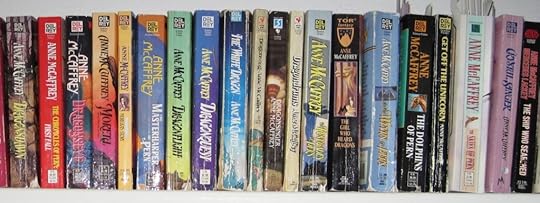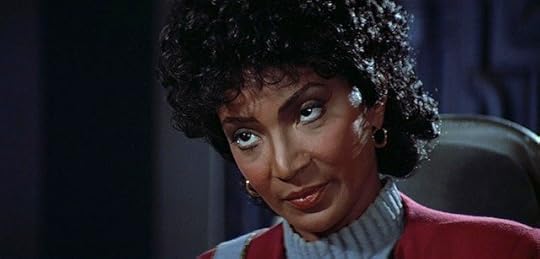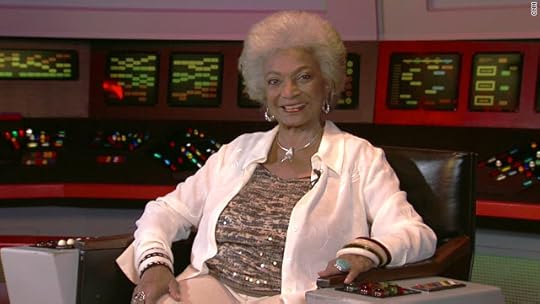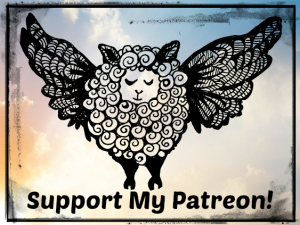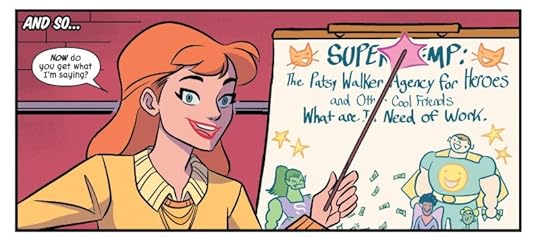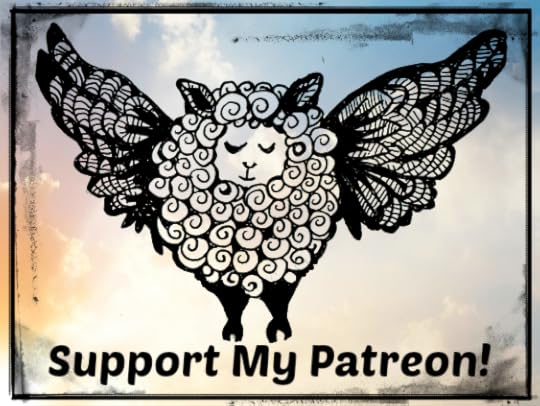Tansy Rayner Roberts's Blog, page 32
February 3, 2016
16. Anne McCaffrey & The Rowan [SF Women of the 20th Century]
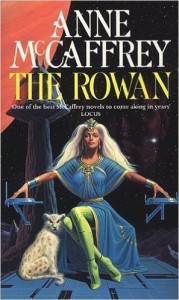 So, I never read McCaffrey’s Pern novels – they remain one of the big gaps in my SFF reading, though my intention has always been to go back and rectify this. (I’ve also never read Bradley’s Darkover series, or Andre Norton’s Witch World – seriously, can’t we agree to some kind of leap year of reading so we can all catch up on the classics?)
So, I never read McCaffrey’s Pern novels – they remain one of the big gaps in my SFF reading, though my intention has always been to go back and rectify this. (I’ve also never read Bradley’s Darkover series, or Andre Norton’s Witch World – seriously, can’t we agree to some kind of leap year of reading so we can all catch up on the classics?)
I read out of second hand shops as much as new shelves (though I bought a *lot* of new releases throughout the 90’s, thanks largely to a generous “clothing allowance” in my teens) but somehow those books never quite passed into my hands – I did come across The Ship Who Sang later, but for the most part my McCaffrey reading was the books coming out at the peak of my SFF discovery period: and that meant the Tower and the Hive series.
The Rowan (1990), the first of this series is a take on the Chosen One trope with added telepathy and a highly technical corporate space transportation system. (oh yes, and a female protagonist) It has a powerful romance thread, though its structure is primarily a coming of age story.
The premise of The Rowan and its sequels is that rare, high-powered telepaths and telekinetics form the spine of a complex system allowing for interstellar teleportation, and widespread interplanetary colonisation without breaking the light barrier. It remains one of my favourite space station novels of all time (I love space station novels far more than spaceship novels, that’s probably something I should have figured out about myself before now), with a great mix of characterisation and social detail combined with the big technical ideas.
There’s an unapologetic femininity about The Rowan – our main character is very much the glamorous space princess who is also a very hard-working and isolated space commander. There are fluffy animals and cute outfits and her hair is amazing. But also, she is one of the most important people in the known universe, and the book is full of science fictional engineering and social ideas. Just thinking about these books all over again makes me want to hug them. (though to be fair I have not reread them since the late 90’s)
I also greatly loved the sequel, Damia, about the Rowan’s daughter and her own responsibilities to the solar system – in fact I think Damia was my favourite because I enjoyed the romance more (and OK maybe because of the silver streak as I had one of my own in my teens – between the Rowan and Damia, no wonder I had a soft spot for this series, I am primed to adore prematurely greying heroines!). There are five Tower and the Hive books in all, the later ones following Damia’s four children, and I liked them less because it felt like the stories were diluted across the multiple characters. What I did love, though, was the combination of the family saga tradition of women’s fiction with SFF worlds – something I had adored just as much when I discovered Jennifer Roberson’s Cheysuli series. It’s surprising to me that we don’t see more family saga structured novels in SFF as it’s a great way to present massive, multi-book adventures (and to tell epic, decades-spanning stories). If you know of some I might have missed, recommend them to me!
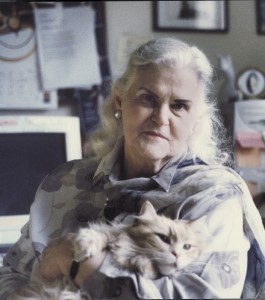 Anne McCaffrey (1926-2011) is one of the biggest names in the science fiction and fantasy world, and one of the most recognisable writers of our field to people outside it – largely because of her massively successful, bestselling Dragonriders of Pern series. She was the first woman to win a Hugo Award for fiction, and the first to win a Nebula. The White Dragon (1978) was one of the very first science fiction novels to appear on the New York Times Best Seller list.
Anne McCaffrey (1926-2011) is one of the biggest names in the science fiction and fantasy world, and one of the most recognisable writers of our field to people outside it – largely because of her massively successful, bestselling Dragonriders of Pern series. She was the first woman to win a Hugo Award for fiction, and the first to win a Nebula. The White Dragon (1978) was one of the very first science fiction novels to appear on the New York Times Best Seller list.
McCaffrey was named a Grand Master of the Science Fiction and Fantasy Writers of America in 2005, and was inducted in the SF Hall of Fame in 2006.
Her career began in the late 1950’s with a couple of short story sales, which developed into book deals after the editor Judith Merril introduced her to Virginia Kidd, who would be her agent for four decades. She wrote The Ship Who Sang throughout the 1960’s in the form of several short stories that would later be combined into a novel, and later turned into a series – late in life, she said that this work was the one she was most proud of. (I always think of this work as being one of the most important and powerful SF books I’ve ever read, and I got legit furious when I looked at the SF Awards Database and realised it had never – won – anything. WTF?)
McCaffrey produced over 90 books in her lifetime, including short story collections and a few non fiction titles along with her main output: science fiction novels. Over the last two decades of her life, she relied more and more on collaborators to get her stories told, working with such writers as Elizabeth Ann Scarborough, Jody Lynn Nye, Mercedes Lackey, SM Stirling, Elizabeth Moon, and her son Todd McCaffrey. She gave Todd and his sister Gigi full permission to write their own stories set in the Pern universe, should they wish to. While many of her works used fantasy tropes and trappings, such as dragons and magic, she always maintained that her work was primarily science fiction, as even her most ‘fantasyish’ novels had a scientific basis – the dragons of Pern, for instance, were genetically engineered.
From her first novel Restoree (which she referred to as a one-off jab at the way women were portrayed in science fiction) all the way to the end, McCaffrey prided herself on writing active, interesting, intelligent female protagonists who are the centre of their own story. She acknowledged her large, passionate female fanbase, though often had to point out that she had male readers too: “Dragons are universal.”
How to Read the Pern series
Revisiting Pern: the Great McCaffrey Reread by Tehani & Marisol
Dragonsong: the Unforgettable Anne McCaffrey by Lev Grossman
Robin Hobb pays tribute to Anne McCaffrey’s influence
The Inspiration of Anne McCaffrey, by Michael Whelan
SF WOMEN OF THE 20TH CENTURY is brought to you by Tansy’s supporters at Patreon.
Patrons of the blog can earn great rewards and help the campaign reach exciting milestones to unlock more content.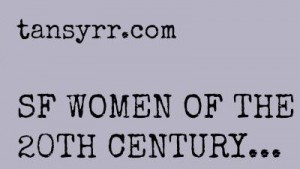 1. Raccoona Sheldon & “The Screwfly Solution”
1. Raccoona Sheldon & “The Screwfly Solution”
2. Diane Marchant & Kirk/Spock
3. Connie Willis & To Say Nothing of the Dog
4. Clare Winger Harris & “The Fate of the Poseidonia”
5. Octavia E. Butler & Dawn
6. Wendy Froud & Yoda
7. C.L. Moore & “No Woman Born”
8. Robin Klein & Halfway Across the Galaxy and Turn Left
9. Joanna Russ & To Write Like A Woman
10. Lois McMaster Bujold & Cordelia’s Honor
11. Naoko Takeuchi & Sailor Moon
12. Leigh Brackett & The Sword of Rhiannon
13. Thea Von Harbou & Metropolis
14. Andre Norton & the High Hallack Library
15. Nichelle Nicholls & Lt. Uhura
January 31, 2016
Sheep Might Fly – Fake Geek Girl Part 2 Show Notes
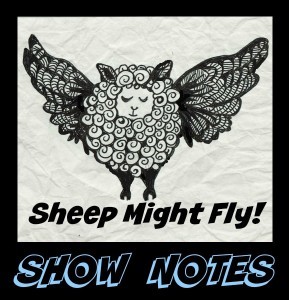 You can listen to the next episode of Sheep Might Fly on iTunes (or your own favourite podcast app, I hope), or stream, download & follow Sheep Might Fly here on the Podbean site.
You can listen to the next episode of Sheep Might Fly on iTunes (or your own favourite podcast app, I hope), or stream, download & follow Sheep Might Fly here on the Podbean site.
Our current story is “Fake Geek Girl,” which was originally published in Review of Australian Fiction Volume 14, Issue 4. You can buy the issue containing the story (along with a fantastic piece from Stephanie Lai) directly from their website.
Meet Fake Geek Girl, the band that plays nerdy songs at the university bar every Friday night, to a mixture of magical and non-magical students: lead singer Holly writes songs based on her twin sister Hebe’s love of geek culture though she doesn’t really understand it; drummer Sage is an explosive sorcerous genius obsessing over whether Holly’s about to quit the band to go mainstream; shy Juniper only just worked up the nerve to sing her own song in public and keeps a Jane Austen themed diary chronicling the lives and loves of her friends. When the mysterious, privileged Ferd joins their share house, everything starts to unravel…
In Episode 2, Sage makes a morally questionable choice while surrounded by coffee fumes, Ferd is adopted by the band, and there’s an app for everything.
Missed Episode 1? Start from the beginning here.
If you like what you hear on Sheep Might Fly, check out Tansy’s blog at tansyrr.com. Talk to Tansy on Twitter (@tansyrr), or check out her other podcasts: Galactic Suburbia and Verity!
You can become a supporter of Tansy & the Sheep Might Fly podcast at Patreon.
January 30, 2016
This Month on the Blog: January 2016
 It’s been a hectic month, school holidays means I spend my time chasing around after my daughters and their social lives, so it’s amazing I get anything done at all! As well as organising sleepovers and playdates, three family birthday events (including a tween camping sleepover), and supervising Ms11 as she entered a 48 hour filmmaking challenge, not to mention launching a new podcast, this is what happened on the blog in January:
It’s been a hectic month, school holidays means I spend my time chasing around after my daughters and their social lives, so it’s amazing I get anything done at all! As well as organising sleepovers and playdates, three family birthday events (including a tween camping sleepover), and supervising Ms11 as she entered a 48 hour filmmaking challenge, not to mention launching a new podcast, this is what happened on the blog in January:
Two new entries in the SF Women of the 20th Century series:
14. Andre Norton & the High Hallack Library
15. Nichelle Nicholls & Lt. Uhura.
Issue #1 comics reviews:
Hellcat
Adventures of Supergirl
The first of my Great Ladies Patreon-sponsored series of essays:
Marie Curie, Radioactive Lady Scientist, requested by Aifin.
But the biggest blog event was of course the launch of my new Sheep Might Fly podcast: Part 1 of Fake Geek Girl. Come back tomorrow for Part 2! The podcast will be uploading Mondays from now on.
Galactic Suburbia is on its summer break, but we still found time to put together a New Year’s special episode (with guests!) and a Star Wars: The Force Awakens Spoilerific.
We’re also in the final hours of Fablecroft’s In Your Face anthology crowdfunding/pre-order campaign: check out me writing about my story, Letters to Cleopatra.
January 27, 2016
Issue #1: The Adventures of Supergirl
 Title: The Adventures of Supergirl #1
Title: The Adventures of Supergirl #1
Writer: Sterling Gates
Artist: Bengal (cover by Cat Staggs)
The Buzz: This digital-first comic is based on the CBS Supergirl series, which provides a whole bunch of in built buzz of its own. More to the point, it’s the cute, fun all-ages Supergirl comic that DC should never NOT have been publishing – given the recognisability factor of Supergirl as a character (my daughter fell in love with her based on an image on a drinking glass), this is the perfect gateway title for young girls to get into comics as a source of adventure stories. Check out this article about how much this comic has been needed.
All You Need To Know: If you’ve watched the pilot of the show (or the extended trailer of same) you pretty much have what you need, and if not this 1st issue is pretty good about covering the basics. Story elements specific to the CBS version of Supergirl include her adopted sister Alex Danvers who works for a covert ops aliens-are-of-interest squad who support and study Supergirl, run by Hank Henshaw. Presumably we’re also going to see the Calista Flockhart interpretation of Cat Grant and ditto for the rest of the office staff, but they’re not in this first issue.
Story: Kara is Supergirl! She has a brief origin story, she punches monsters, and her sister is in danger! It’s basic stuff, and as with all digital first comics the issues are too short to really get a handle on what they’re doing (three of these are equivalent to one traditional comic, hence the price point). Most adult readers will probably not find this especially challenging or innovative (it doesn’t have the raw cheeky humour you find in a Hellcat or a Squirrel Girl), but it’s so long since there’s been an uncomplicated, light-hearted Supergirl comic I would actually feel okay about handing to my kids that I’m still delighted to see it. More importantly, it feels exactly like the Supergirl we get in the highly-accessible-to-newbies show, so is the perfect first comic to offer to those who have discovered a love of superheroes thanks to CBS and Kara.
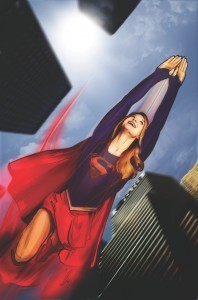 Art: This is the big one for me – it’s inoffensive! That may sound like damning with faint praise, but it’s not. Four years ago, when I was desperately hunting for Supergirl product to feed my hungry daughter, I was really distressed at the way that the character (especially when portrayed as a teenager) was so often needlessly sexualised in comics, the short skirt being used as an excuse to twist and contort her into stripper poses, and so on. This Kara is drawn respectfully, and I like how many of her poses are of strength rather than passivity or random sexuality. This is not rare to find these days – not compared to only a few years ago – but it’s still one hell of a relief.
Art: This is the big one for me – it’s inoffensive! That may sound like damning with faint praise, but it’s not. Four years ago, when I was desperately hunting for Supergirl product to feed my hungry daughter, I was really distressed at the way that the character (especially when portrayed as a teenager) was so often needlessly sexualised in comics, the short skirt being used as an excuse to twist and contort her into stripper poses, and so on. This Kara is drawn respectfully, and I like how many of her poses are of strength rather than passivity or random sexuality. This is not rare to find these days – not compared to only a few years ago – but it’s still one hell of a relief.
But What Did I Miss?: You definitely don’t have to have read the show for this one, which sums up the character’s origin and set up nicely. I’d be interested to see how the comic adapts to various character-progress reveals later in the season, or if it’s going to stay grounded in the current ‘early episodes’ feel.
Would Read Issue 2?: I am intrigued, but as with many digital comics I am likely to wait until they have a lot banked up, then mainline them – these tiny bites don’t quite fit with how I like to consume comics.
Read it if you Like: CBS’ Supergirl, Gotham Academy, Superman Family Adventures, older comics (80’s Teen Titans etc.), superhero cartoons like Justice League Unlimited.
Other titles reviewed in 2016:
Hellcat #1
January 26, 2016
15. Nichelle Nichols and Lt. Uhura. [SF Women of the 20th Century]
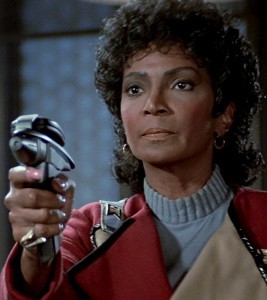 Last year, 83-year old actress, singer and voice actor Nichelle Nichols made headlines when she joined the NASA space observatory flight, on a mission to observe space through the SOFIA telescope on a modified Boeing 747 plane.
Last year, 83-year old actress, singer and voice actor Nichelle Nichols made headlines when she joined the NASA space observatory flight, on a mission to observe space through the SOFIA telescope on a modified Boeing 747 plane.
This was a culmination of a long history between Nichols and NASA. After playing the iconic Lt Uhura in the 1960’s TV show Star Trek (one of the first prominent roles on TV played by an African American woman), Nichols went on to serve as an astronaut recruiter, inspiring women and minorities to train for space. She recently won the Ed Dwight Jr Award for her work in this area.
Guion Bluford, the first African American in space, was one of Nichols’ recruits. He flew four space missions, starting in 1983. Other astronauts recruited by Nichols include Dr Sally Ride, the first female American astronaut in space, and Charles Bolden, one of America’s most accomplished astronauts who now serves as the Administrator of NASA.
(This is the sort of thing worth talking about when people complain that representation in pop culture isn’t as important as real life.)
Nichols’ career began with performing in musicals, along with modelling and singing. After roles in stage productions of Porgy and Bess and Carmen Jones, she toured across the US, Canada and Europe with the Duke Ellington and Lionel Hampton bands.
 The role of Uhura in Star Trek was groundbreaking in many ways – though the part itself was often thankless. As the chief communications officer, Uhura was present and visible on the bridge of the Enterprise, though scripts very rarely gave her as much to do as the men. (after Leonard Nimoy’s death it was widely reported by his castmates that he had, among fighting other inequities, argued with management to raise Nichols’ salary when he realised the male regulars on set were being paid more) Uhura formed part of a culturally diverse crew, which was an important part of Gene Roddenberry’s vision of the future of humanity and made a stark contrast to the all-American, all-white, mostly-male casts for other science fiction films and shows.
The role of Uhura in Star Trek was groundbreaking in many ways – though the part itself was often thankless. As the chief communications officer, Uhura was present and visible on the bridge of the Enterprise, though scripts very rarely gave her as much to do as the men. (after Leonard Nimoy’s death it was widely reported by his castmates that he had, among fighting other inequities, argued with management to raise Nichols’ salary when he realised the male regulars on set were being paid more) Uhura formed part of a culturally diverse crew, which was an important part of Gene Roddenberry’s vision of the future of humanity and made a stark contrast to the all-American, all-white, mostly-male casts for other science fiction films and shows.
In one episode, Uhura kisses Captain Kirk while they are under the influence of aliens – and this is believed to be the first interracial kiss on US television. Whoopi Goldberg, who played the recurring role of Guinan in Star Trek: Next Gen decades later, has spoken many times about being a young viewer of the show, and how important it felt to see a black woman on television who wasn’t a maid – and, especially, to see a black woman in a science fictional future.
Famously, Nichols considered leaving the show after the first year, in order to take a part in a play heading for Broadway. She changed her mind after a conversation with Dr Martin Luther King, Jr who was a fan of Star Trek (and Uhura in particular). Approaching her at a fundraiser, he talked to her about how Star Trek was the only show he and his wife allowed their children to stay up and watch past their bedtime. He was distressed to hear of her recent resignation, and convinced her of the value of her visibility in this imagined future of greater racial harmony and co-operation:
“Don’t you understand what this man has achieved? For the first time on television, we will be seen as we should be seen, every day, as intelligent, quality, beautiful, people who can sing, dance… who can go into space. Who can be lawyers, who can be teachers, who can be professors – who are in this day, and yet you don’t see it on television, until now… Gene Roddenberry has opened a door for the world to see us. If you leave, that door can be closed… your role is not a black role. And it’s not a female role. He can fill it with anyone including an alien.”
Two days later, she told Roddenberry that she had changed her mind, and he returned her resignation letter, torn into many pieces.
As Uhura, Nichols went on to be one of the cast members who took part in the animated series of Star Trek in the 70’s and, more crucially, the series of six films from 1979-1991 which followed a group of the original cast further into the future. Uhura was the only woman from the original cast who was featured prominently in all six of the films alongside the male characters Kirk, Spock, Bones, Sulu, Chekhov and Scotty – Majel Barrett and Grace Lee Whitney only appeared very briefly in a couple of the films as Christine Chapel and Janice Rand.
Uhura was promoted to commander in the later films, and several Star Trek tie-in novels made it clear that she ended up a captain in her own right. The character is now played by Zoe Saldana in the reboot movies, with much greater emphasis placed on the linguistic and academically difficult aspects of Uhura’s job, as well as a romantic relationship with Zachary Quinto’s Spock (which many believe existed in subtext in the original show, though was not allowed to come to fruition because of the controversy around interracial relationships on 1960’s television).
Nichols has co-written two science fiction novels (set in a similar future to the Star Trek universe): Saturn’s Child and Saturna’s Quest. She also wrote her own autobiography: Beyond Uhura – Star Trek and other Memories, and has released two music albums.
She continues to entertain and inspire here in the 21st century.
SF WOMEN OF THE 20TH CENTURY is brought to you by Tansy’s supporters at Patreon.
Patrons of the blog can earn great rewards and help the campaign reach exciting milestones to unlock more content. 1. Raccoona Sheldon & “The Screwfly Solution”
1. Raccoona Sheldon & “The Screwfly Solution”
2. Diane Marchant & Kirk/Spock
3. Connie Willis & To Say Nothing of the Dog
4. Clare Winger Harris & “The Fate of the Poseidonia”
5. Octavia E. Butler & Dawn
6. Wendy Froud & Yoda
7. C.L. Moore & “No Woman Born”
8. Robin Klein & Halfway Across the Galaxy and Turn Left
9. Joanna Russ & To Write Like A Woman
10. Lois McMaster Bujold & Cordelia’s Honor
11. Naoko Takeuchi & Sailor Moon
12. Leigh Brackett & The Sword of Rhiannon
13. Thea Von Harbou & Metropolis
14. Andre Norton & the High Hallack Library
January 25, 2016
Sheep Might Fly – Fake Geek Girl Part 1
 New podcast! It’s not up on iTunes yet, but for now you can stream, download & follow Sheep Might Fly over on the Podbean site.
New podcast! It’s not up on iTunes yet, but for now you can stream, download & follow Sheep Might Fly over on the Podbean site.
Our first story is “Fake Geek Girl,” which was originally published in Review of Australian Fiction Volume 14, Issue 4. You can buy the issue containing the story directly from their website.
Meet Fake Geek Girl, the band that plays nerdy songs at the university bar every Friday night, to a mixture of magical and non-magical students: lead singer Holly writes songs based on her twin sister Hebe’s love of geek culture though she doesn’t really understand it; drummer Sage is an explosive sorcerous genius obsessing over whether Holly’s about to quit the band to go mainstream; shy Juniper only just worked up the nerve to sing her own song in public and keeps a Jane Austen themed diary chronicling the lives and loves of her friends. When the mysterious, privileged Ferd joins their share house, everything starts to unravel…
In Episode 1, Hebe meets a boy she likes! With a phoenix tattoo! Hebe + Phoenix Boy = OTP
If you like what you hear on Sheep Might Fly, check out Tansy’s blog at tansyrr.com. Talk to Tansy on Twitter (@tansyrr), or check out her other podcasts: Galactic Suburbia and Verity!
You can become a supporter of Tansy & the Sheep Might Fly podcast at Patreon.
January 19, 2016
MARIE CURIE: RADIOACTIVE LADY SCIENTIST
 Great Ladies of History is a Patreon-sponsored blog series for tansyrr.com! One of the rewards at the $10 tier (Great Ladies Patron!) and at the $20 tier (Deluxe Super Special Queen-Emperor of Glorious Patronage) gives you the magical ability to choose any woman of history, fiction or art (yes, superhero comics count) to write a short essay about. As always the word ‘great’ has many potential meanings…
Great Ladies of History is a Patreon-sponsored blog series for tansyrr.com! One of the rewards at the $10 tier (Great Ladies Patron!) and at the $20 tier (Deluxe Super Special Queen-Emperor of Glorious Patronage) gives you the magical ability to choose any woman of history, fiction or art (yes, superhero comics count) to write a short essay about. As always the word ‘great’ has many potential meanings…
You can check out this and many other exciting Patreon rewards at my sponsorship page.
This essay is sponsored by Patreon supporter Andrew Finch, AKA the Silent Producer.
MARIE CURIE: RADIOACTIVE LADY SCIENTIST
Madame Marie Sklodowska Curie (1867-1934), also known as the first (and often only) female scientist of history that anyone can name, was a Polish scientist famous for her work in physics and chemistry, and being a pioneer of studies into radioactivity. She developed techniques for isolating radioactive isotopes, discovered two elements, polonium and radium, and even coined the term ‘radioactivity’. She also established mobile X-Ray machines for use during World War I. Marie was the first woman to win the Nobel Prize (and then did it again for good measure).
Growing up in Russian-occupied Warsaw, Marie Sklodowska was not allowed to apply to university because she was a girl. She and her sister Bronya defied Russian authorities to continue their education in the Flying University, an underground pro-Polish educational programme which operated out of people’s private houses. Marie then worked as a tutor and a governess to help pay for Bronya to get an official degree in Paris, on the understanding that Bronya would do the same for her. Years later, Marie herself reached Paris, to study physics, chemistry and mathematics at the Sorbonne. She met her future husband Pierre Curie after graduation, when a friend made arrangements for her to use some of his spare laboratory space.
 Their marriage became a grand scientific collaboration. Marie was greatly interested in the new X-Ray process and began investigating uraniam rays using a version of the electrometer invented by Pierre and his brother 15 years earlier. Her studies eventually led to disproving the ancient theory that atoms could not be divided, and she also discovered that thorium was radioactive (despite speedy publication, a German scientist beat her to the punch in presenting this particular discovery). Her work was so interesting that Pierre finally laid aside his own projects to join her, their combined efforts ultimately culminating in a shared Nobel Prize – though the committee initially did not plan to include Marie in the prize, until Pierre found out about it and protested. They spent the money from the prize on hiring their first lab assistant. After Pierre’s death (he was run over by a carriage in Paris), Marie took over his teaching chair at that Sorbonne, becoming their first female professor.
Their marriage became a grand scientific collaboration. Marie was greatly interested in the new X-Ray process and began investigating uraniam rays using a version of the electrometer invented by Pierre and his brother 15 years earlier. Her studies eventually led to disproving the ancient theory that atoms could not be divided, and she also discovered that thorium was radioactive (despite speedy publication, a German scientist beat her to the punch in presenting this particular discovery). Her work was so interesting that Pierre finally laid aside his own projects to join her, their combined efforts ultimately culminating in a shared Nobel Prize – though the committee initially did not plan to include Marie in the prize, until Pierre found out about it and protested. They spent the money from the prize on hiring their first lab assistant. After Pierre’s death (he was run over by a carriage in Paris), Marie took over his teaching chair at that Sorbonne, becoming their first female professor.
In 1910, Marie’s work on isolating radium came to a head (the international standard for measuring radioactive emissions came to be named the curie in her and Pierre’s honour) and won a second Nobel Prize, this time for chemistry. She was the first person to win two Nobel prizes, and remains the first to have won the Nobel for two separate sciences.
 Oh, and she did all this while sole parenting small children! Their daughters Irene and Eve were seven and two years old when Pierre Curie died.
Oh, and she did all this while sole parenting small children! Their daughters Irene and Eve were seven and two years old when Pierre Curie died.
While they knew the importance of publishing their theories so as to ensure they (and particularly Marie) received due credit for their work, the Curies did not patent their discoveries around radium, and so they did not profit greatly from it, even as the medical field discovered its many important uses. During World War I, Marie herself saw the benefit of developing mobile radiography units to help field surgeons, and quickly familiarised herself with a basic medical education before procuring the necessary equipment in order to establish and become the director of the Red Cross Radiology Service in France. Approximately one million French soldiers were treated with her mobile units.
Sadly, no one at the time of the potential hazards of working with radioactive materials, and the lack of protective processes in the laboratory she had shared with Pierre led to Marie’s own death in her sixties, of aplastic anaemia caused by extensive exposure to radioactivity. Famously, she had been known to keep radioactive isotopes in her pockets, and in her desk drawers – even now, her papers are dangerously contaminated and are kept in lead lined boxes for safety.
Marie’s daughter Irene Joliot-Curie and son-in-law Frederic Joliot-Curie went on to win the Nobel Prize for Chemistry in 1935 for their joint work in discovering artificial radioactivity, one year after Marie’s death. Irene died of leukemia at the age of 58 in 1956. Her illness was believed to be connected to an accidental exposure to polonium she had suffered after a lab explosion ten years earlier. Irene’s younger sister Eve, the only non-scientist in the family, became a celebrated journalist and her mother’s biographer as working extensively with the charity UNICEF. She lived to be 102.
Greer Garson as Marie Curie
Marie Sklodowska Curie has had all manner of great posthumous honours, including two museums – one in Warsaw and one in Paris. She has also become something of a cult favourite in modern pop culture, thanks largely to a somewhat gleeful interest in the manner of her death, as well as her aforementioned First/Only Female Scientist Anyone Can Remember status. Because of this she has turned up in all manner of creative and fictional projects including films, plays, television and novels – at one point notably played by Greer Garson, with Walter Pidgeon as Pierre. She even turned up in the role of love interest in the oddball Australian cult movie Young Einstein (1988) played by Odile LeClezio. She has appeared on postage stamps, bills and coins around the world, and three radioactive minerals: curite, sklodowskite, and cuprosklodowskite. She has had a bridge, a nuclear reactor and a Paris metro station named after her. The Marie Curie Actions Fellowship is a scholarship fund designed for students wishing (or needing) to study in foreign countries.“We must not forget that when radium was discovered no one knew that it would prove useful in hospitals. The work was one of pure science. And this is a proof that scientific work must not be considered from the point of view of the direct usefulness of it. It must be done for itself, for the beauty of science, and then there is always the chance that a scientific discovery may become like the radium a benefit for mankind.”
– Marie Sklodowska Curie
January 13, 2016
Issue #1: Hellcat (2016)
 Title: (Patsy Walker, AKA) Hellcat #1
Title: (Patsy Walker, AKA) Hellcat #1
Writer: Kate Leth
Artist: Brittney Williams
The Buzz: Marvel made several genius moves with this particular title – announcing it just as Trish “formerly known as Patsy” Walker was winning hearts as the BFF with superhero aspirations in the Netflix series Jessica Jones, and putting together a fantastic creative team whose involvement practically creates its own buzz – writer Kate Leth is a Tumblr comics queen (kateordie.tumblr.com/) who has been making a name for herself in all-ages tie in comics like Adventure Time and Bravest Warriors. Brittney Williams is the current artist on Lumberjanes, one of the biggest hits of the recent wave of indie girl-centred adventure comics.
As a side note, apparently the biggest criticism that (male) comics “fans” can make about Hellcat is that it is “copying” Squirrel Girl and Ms Marvel by being a fun, kid-friendly comic about mostly women, and surely we have enough of those already? NO WE DO NOT HAVE ENOUGH, BACK IN YOUR CORNER! The biggest problem the comics industry has had over the last several years has been trying to aim all of their comics at a single (largely ungrateful) demographic instead of spreading the appeal a bit more widely, and the lack of comics suitable for the under twelves to read has been especially galling. Very few of us are going to shell out for 52 (or whatever) superhero comics every month, but aiming more than 2 at younger female readers, and trying to offer more in a similar vein to those readers who love Squirrel Girl or Ms Marvel makes a whole lot of commercial sense. (it’s not like we don’t have approximately a zillion comics about angsty punching dudes)
All You Need To Know: IT’S PATSY! Patsy Walker is one of Marvel’s oldest and quirkiest of superheroes. She started out as the sassy heroine of romance comics (like if Archie was a girl), only to be seduced over to the cape-and-magic side of the publishing arm. She’s had dark horrid stories and bright cheerful stories along the way, and her current Marvel backstory presents her romance comics past as fictional: her mother wrote & drew cutesy books about her youthful exploits, making her a teen celebrity. Yes, much like James Tiptree Jr. (In Netflix’s Jessica Jones, this was cleverly retold as the saga of a teen TV star with a pushy, abusive stage mother, who still gets remembered for her red wig and retro comics appearances) However, everything you need to know about Patsy Walker AKA Hellcat is pretty much here in #1.
Story: Patsy AKA Hellcat is having a bad day – her BFF and boss, lawyer Jennifer Walters, can’t afford to keep her on as firm investigator any more, and that means she has to move out of the storage cupboard where she’s been living. Oh, and it turns out that her teen frenemy has brought the old Patsy comics back into print without her permission… but things are looking up, too, with an old friend back in her life as well as a brand new friend – Ian, a hapless Inhuman on the verge of becoming a supervillain because the moneymaking opportunities for superhumans is weirdly scarce. And that’s when Patsy gets her brilliant new business idea!
This is a fun romp of a comic all about friendship and everyday shenanigans, which reminds me not only of the obvious recent ‘girl comics’ hits, but also fun superhero sitcom eras like early Justice League International. Patsy is a breath of fresh air, a bit of a scamp with a strong sense of justice. I literally just placed this in my daughter’s hands and ordered her to read it.
Art: Cute, bright and fun – as with the other comics in the current wave of success (including Batgirl, Gotham Academy and Black Canary as well as Squirrel Girl, Ms Marvel and Lumberjanes and NO THAT STILL IS NOT TOO MANY, the art style owes a lot more to indie webcomics than to traditional superhero comics art. Which means faces with lots of humour and characters, diverse body types, and a distinct lack of gratuitous physics-bending cheesecake. Gee, I wonder why female readers really respond to this style over “tradition”? There’s a lot of physical humour depicted here, and I was a little startled (but ultimately charmed) by Patsy’s occasional metamorphosis into a child-like figure instead of her usual twenty-something appearance, but I’ve read enough manga to get the visual joke of it – it only happens when she’s being especially kid-like or squeeful. I also appreciated that She Hulk is drawn in a similar style to her last title, which is respectful and still refreshing after decades of her being presented visually as a plus-sized model in artfully draped scraps of fabric. She’s far more power fantasy than sex fantasy these days, which is another element that makes the comic friendly to all-ages readers
But What Did I Miss?: Not much, this is a great introduction, though I highly recommend the most recent She-Hulk run (it’s only 12 issues) for more Jen and Patsy interactions – many of the supporting characters in this issue were first introduced there. Also, the recent Gwenpool Holiday Special (which I am kicking myself I didn’t read until after Christmas) – not only has a fantastic little Hawkeyes-and-Deadpool romp but revolves around the building where She-Hulk rents her superhero-friendly office space from Sharon. Partying with Hellcat will save the day!
Would Read Issue 2?: Why is it not on my iPad already???
Read it if you Like: The Unbreakable Squirrel Girl, She-Hulk, Justice League International, Justice League 3001, Gotham Academy, Kate or Die, Gunnerkrigg Court, Ms Marvel, Lumberjanes, Supergirl the TV series, or if you wished Netflix’s Jessica Jones had a comedy musical episode.
January 11, 2016
14. Andre Norton & the High Hallack Library [SF Women of the 20th Century]
 So I recently read my first Andre Norton book. I know, right?
So I recently read my first Andre Norton book. I know, right?
It was Sargasso of Space (1955), one of her classic SF juveniles written originally under the name Andrew North, and I enjoyed it well enough though it is everything about classic SF that makes me tired – male heroes and anti-heroes having boy’s own adventures as far as the eye can see. (In retrospect I think I would probably enjoy the Witch World series much more, and I have loaded up on super cheap Andre Norton omnibus editions thanks to my Kindle – I’m determined to find one that I love!)
It’s not surprising at all that she became such a popular writer in the genre, being able to write that classic, traditionally masculine style of science fiction so deftly. But Sargasso of Space comes at the very beginning of Norton’s long career, and is only a small piece of the picture.
She wrote over 130 novels in all, over 70+ years (she died in her 90’s).
She was the only woman to be named a SFWA Grand Master during the 20th century (in 1984).
She was also the first woman to receive a Gandalf Award (1977), and the first women to be inducted into the Science Fiction Hall of Fame (1997).
She was honoured with the World Fantasy Convention Lifetime Achievement Award in 1998, and went on to write or co-write at least 19 more books after that.
Yes, that’s actually the level of achievement you have to get to in order to be remembered and occasionally spoken of in the same breath as Heinlein and Asimov. Andre Norton is one of those female authors who make such an extraordinary contribution that no one can deny her place in history. But *wow* that’s a high bar against which to measure other writers.
There are so many interesting things to discuss around the legend of Andre Norton: her epic Witch World series, which ran to several dozen books, blended SF and fantasy, and brought slews of female readers to the SFF genre; her many awards; her many masculine pen-names; the Norton Award named after her which runs in association with the Nebulas and honours YA speculative fiction; her collaborative works.
(The reason behind the Norton Award is that Norton’s work was hugely influential on many generations of SF readers and writers, with many of her novels written originally as “juveniles,” aimed at an audience of young readers, despite often having adult heroes.)
The aspect of her career which most stood out for me was the High Hallack Genre Writer’s Research and Reference Library which Andre Norton founded in 1999. This research library (named after the High Hallack cycle of Witch World stories) focused on popular genres, and she acquired over 10,000 books for it, stored in a converted garage.
I can’t imagine any SF writer who would not have ‘start my own research library’ on their own bucket list, in the eventuality of mega success.
The announcement of the library described it thus: “the facility is open to any writer or a student enrolled at college level or higher, currently engaged on a piece of genre-related writing, whether fiction or non-fiction. The use of library as well as lodging of up to one week, with extensions negotiable, is free of charge; however, guests may make a donation to the library, which is a tax-exempt institution.”
Seriously, living the dream or what? I totally want to go back in time and take her up on that offer.
Sadly, the High Hallack library only lasted for five years, until Norton’s ill health forced her to sell off the collection and close it down.
The opening of High Hallack: http://www.andre-norton.org/highhallack/opening.html Also, check out this gallery of lovely pictures by Angela Cole, one of the library’s visitors.
Norton’s obituary in the Guardian.
Norton’s TV Tropes page.
 SF WOMEN OF THE 20TH CENTURY is brought to you by Tansy’s supporters at Patreon.
SF WOMEN OF THE 20TH CENTURY is brought to you by Tansy’s supporters at Patreon.
Patrons of the blog can earn great rewards and help the campaign reach exciting milestones to unlock more content.
1. Raccoona Sheldon & “The Screwfly Solution”
2. Diane Marchant & Kirk/Spock
3. Connie Willis & To Say Nothing of the Dog
4. Clare Winger Harris & “The Fate of the Poseidonia”
5. Octavia E. Butler & Dawn
6. Wendy Froud & Yoda
7. C.L. Moore & “No Woman Born”
8. Robin Klein & Halfway Across the Galaxy and Turn Left
9. Joanna Russ & To Write Like A Woman
10. Lois McMaster Bujold & Cordelia’s Honor
11. Naoko Takeuchi & Sailor Moon
12. Leigh Brackett & The Sword of Rhiannon
13. Thea Von Harbou & Metropolis
January 10, 2016
Patreon 2016: Sheep Might Fly & Other Epic Possibilities
cover art by Katy Shuttleworth
So, I have a Patreon page where readers of the blog (and those who enjoy my writing generally) can support my work. First it was for the grand, entirely epic Musketeer Space project, which can be read for free here. In 15 months I wrote 62 chapters, a bonus novella, 20 Musketeer Media Essays and rewatched 73 episodes of the classic space opera cartoon Robotech.Then while I took a breather from the pressures of writing (and publishing) a chapter a week of what had turned into a life-swallowing 190,000 word space adventure, the Patreon became a more general way to support my blogging, including a series of SF Women of the 20th Century profiles (still ongoing).
But I always meant to come back to writing fiction serials, because I’m addicted to the form now! And given my other love of podcasting, I thought it was time to combine the two…
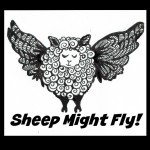 So from February I am launching Sheep Might Fly, a weekly podcast which will feature me, reading serialised long-short fiction (of the novelette/novella range, with episodes running to somewhere between 5 minutes and 20 minutes per week).
So from February I am launching Sheep Might Fly, a weekly podcast which will feature me, reading serialised long-short fiction (of the novelette/novella range, with episodes running to somewhere between 5 minutes and 20 minutes per week).
Some of the stories – like Fake Geek Girl, my magical university share house novelette published in Review of Australian Fiction last year, which I am adapting for the February-March launch of the podcast – have been previously published, but I plan to alternate these with original stories written directly for the podcast serial format.
After Fake Geek Girl, the first original serial (starting in April) will be Glass Slipper Boys, a story of tabloid reporters in a fairy tale kingdom, featuring my own deconstruction of the Prince Charming archetype.
I haven’t locked in future serials yet, but I know I want to adapt some of the stories from my Love and Romanpunk collection, and I also want to take the opportunity to write & publish stories in the same worlds of my favourite pieces of the last couple of years – more superhero stories in the same universe as “Cookie Cutter Superhero” from Kaleidoscope, more ‘Heroides’ stories addressing the heroes of Greek myth, more Fake Geek Girl stories, and more stories set in the Dragon Circus (the first of which is due to be published by ClanDestine Press later this year). I also want to return to epic fantasy in the vein of The Creature Court, proving beyond all doubt that it is possible to write ‘epic’ in 30,000 words or less.
If you love listening to fun SFF fiction, then Sheep Might Fly is totally the tansyrr.com project for you! Please consider becoming a sponsor via Patreon. If my monthly sponsorship total hits $250 by Australia Day (26 January), I’ll even start the podcast a week early!
If listening to fiction is not your favourite thing, then I will be continuing the Patreon-sponsored SF Women of the 20th Century blogging series in 2016, as well as other online writing made possible by Patreon support. Supporters also receive rewards based on the tiers they choose, which can include telling me things to write about, glitter art, postcards, etc. Plus of course my eternal gratitude for your support.
Also for those who prefer to read instead of listen, I will be sending out a bonus ebook of each original (not the reprints) Sheep Might Fly serial after it has completed its run on the podcasts, to every Patreon supporter, which will probably mean 2-3 stories per year.
I’m excited by this new project, combining so many of the things that I love – my intention is that it will be less overwhelming & more sustainable than the Musketeer Space project was, allowing me to work on the short fiction and blogging that I love, and offer interesting creative content across different media to my beloved Patreon supporters, while still leaving me time to write novels and take care of my family.

